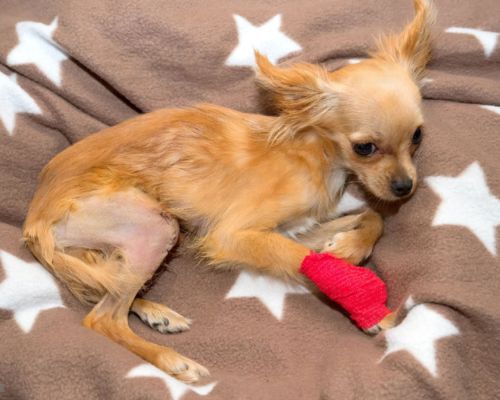Pet Patella Luxation
If your dog has been hopping around, walking strangely, or keeps stretching its legs, it could be a possible sign of luxating patella.
Pet Patella Luxation in Shawnee, OK
At Northside Veterinary Hospital, we are highly experienced in diagnosing and compassionately treating canine luxating patella. Read on to learn more about the condition.
What Is Patella Luxation?
The patella (knee cap) is a tiny bone that sits on the groove of the femur (thigh bone) and glides up and down when the knee is extending. In some dogs, the patella dislocates (luxates) from its normal position. Therefore, a luxating patella is a condition whereby the kneecap shifts out of alignment with the thigh bone groove when the knee is flexed and extended. The knee cap may veer on the leg’s inside (medial) or outside (lateral). The condition can affect both knees in about 50% of dogs resulting in discomfort and function loss.
This condition is among the most common orthopedic conditions in dogs and can affect them at any age. Patella luxation can also occur in cats, especially domestic short-haired cats, and is trauma related though rare.
Causes of Patella Luxation
Patella luxation is a developmental, congenital defect and can also be caused by blunt trauma(rare). Genes and obesity also contribute to the condition.
Small or toy dog breeds are commonly affected by patella luxation when the patella groove does not develop well enough to maintain stability when tracking along its anatomical track due to inappropriate breeding practices. Since patella luxation is a genetic condition, dogs diagnosed with the disorder should not be bred.
Patella luxation is also a consequence of complex skeletal abnormalities affecting limb alignment, including:
- Tibia malformation
- Hip joint abnormal conformation
- Excessively long patellar ligament
- Tibia crest deviation
- Tight quadriceps muscles
- Femur malformation, including torsion and angulation abnormalities
Types of Dog Breeds Affected by Patella Luxation
Patella luxation can affect all dog breeds, including tiny breeds such as:
- Pomeranian
- Chihuahua
- Miniature poodle
- Yorkshire terrier
- Lhasa apso
- Pugs
- Papillion
- French bulldog
- Shih-Tzu
- Boston terrier
- Cavalier King Charles Spaniel
- West Highland White Terrier
- Jack Russell Terrier
- Bichon Frise
- Bulldog
- Maltese
- Patterdale Terriers
- Pekingese
- French Poodle
- Plummer terriers
- Teddy Roosevelt Terriers
Over the years, large breed dogs are also predisposed to patella luxation, such as:
- Labrador retriever
- Chinese Shar Pei
- Akitas
- Great Pyrenees
- Flat-Coated Retrievers
What Are the Symptoms of Patella Luxation in Dogs?
Symptoms vary with the severity of the condition. Most dogs begin to show signs and symptoms as puppies or young adults, generally three years old, and this is also becoming more evident in mature dogs. Patella luxation is characterized by lameness, causing your dog to hop, skip, or run on three legs, where they suddenly carry the limb up for several steps and then quickly return to normal. Your dog may also stretch its legs sporadically and may shake or extend its leg before entirely using the affected leg. Your dog may yelp out in pain when its kneecap dislocates with a faint clicking sound when the patella abruptly comes out of its groove, with the pain subsiding in a few hours.
If more than one leg is affected, the dog may “bunny hop” or drag the legs for a short time, with an awkward, stiff gait with knees having difficulty extending. Over time, this may lead to arthritis. Once patella luxation progresses in severity and duration, lameness may eventually become continuous. The rear legs of young puppies with severe medial patellar luxation appear bow-legged, worsening as it grows, while large dogs with lateral patellar luxation have a knocked-knee appearance. Dogs with patella luxation develop coping mechanisms to deal with the pain and abnormality. When the puppy is young, the pain is mild and progressively worsens due to the development of arthritis from the instability of the knee cap. Arthritis develops when the cartilage erodes due to the knee cap continuously dislocating out of its groove. Arthritis is an irreversible condition. Additionally, the luxating patella may affect knee stability and lead to the development of severe injuries like a torn cruciate ligament.
Luxation Patellar Diagnosis
Your dog’s vet will diagnose the condition through a physical examination by feeling the knee joint and taking into account any signs of discomfort you might have noticed in your dog.
The vet may also order additional tests to diagnose conditions associated with patella luxation, including:
- A 3D CT (computed tomography) scan to provide pictures of the skeletal system’s rear legs
- Palpitation Knee under sedation to check for ligament damage
- Blood and urine analysis (precautionary measure before anesthesia)
- Tibia, knee, and pelvis X-rays to evaluate the rear leg’s bone shape, knee structure, and hip dysplasia
After diagnostic imaging, your dog may require surgery to correct the affected joint.
Patella Luxation Grading System
Patella luxation has four diagnostic grades based on severity which include:
- Grade I: The patella can frequently and easily dislocate out of its normal position with manual pressure, then immediately pop back in when released. Grade I does not present clinical symptoms.
- Grade II: The patella readily pops out of its initial position with stifle flexion or manual pressure. It remains luxated until stifle extension or is manually pushed back to its normal position. Lameness is intermittent at this stage and can be painful if the cartilage is damaged by frequent luxation.
- Grade III: The patella is luxated most of the time and can be returned to its normal position manually but will re-luxate spontaneously once manual pressure is removed. Dogs may experience more pain and lameness at this stage due to cartilage damage and limb structure changes.
- Grade IV: The patella is permanently luxated and cannot be manually replaced. At this stage, severe limb structure changes lead to lameness, reduced limb function, and impaired mobility issues.
Luxating Patella Treatment
Early diagnosis and treatment are crucial to prevent severe lameness later in life, so if you notice your dog is exhibiting patella luxation symptoms, take it to the vet as soon as possible. Treatments range from conservative methods to surgical procedures depending on the severity of the disease. Preliminary treatment may involve glucosamine to strengthen ligaments and surrounding joint tissues. Nonsteroidal anti-inflammatory drugs (NSAIDs) and analgesics may be administered to reduce pain.
Pet stairs, ramps, and steps help with mobility issues without adding pressure, damage, or discomfort to the joint. Grade I and II are treated with pain relief drugs and anti-inflammatory medication. Weight loss management and restricted exercises are also recommended. Your vet may also recommend rehabilitation to regain muscle strength and enable your dog to return to normal activities.
Surgery is necessary when your dog has persistent or recurrent lameness or if there is a secondary injury to patella luxation. Surgery realigns the knee joint’s supporting tissues, restoring the patella’s normal function. The type of surgery required depends on the type of abnormality.
Grade I patellar luxation does not require surgical repair. In contrast, dogs with grade II that experience significant pain and lameness may require surgery to relieve pain and improve their quality of life. Grades III and IV require surgery if the dog has difficulty walking due to pain and lameness. When both rear limbs are affected, the most affected leg is operated on first. Occasionally, grade IV may require more complex surgery to realign the tibia and femur. Common surgeries include:
- Soft tissues surrounding the patella are reconstructed to loosen or tighten either side of which the patella is riding.
- Deepening the groove on the femur allows the patella to sit in place using different techniques.
- Reinforcing the patella’s soft tissues prevents the patella from luxating again. An implant may be placed inside the knee to prevent the patella from slipping over. The abnormal shape of the femur that angles the patella to dislocate may also be surgically corrected.
- Realigning the tibial crest to allow the quadricep muscle to pull the patella into the groove versus pulling it out of the groove.
After surgery, your dog may wear a soft brace or bandage for about a week, and exercise should be restricted for 4 to 8 weeks after surgery. Dog walks should also be limited. You may have to confine your dog in a small room or cage at home to restrict its movement and activity until it is healed. You will be advised on how to take care of your dog. Most surgery outcomes are significantly successful, and recurrence is uncommon.
For a customized treatment plan for patella luxation in your dog or cat and more information about the injuries and other conditions we treat, contact Northside Veterinary Hospital today.

